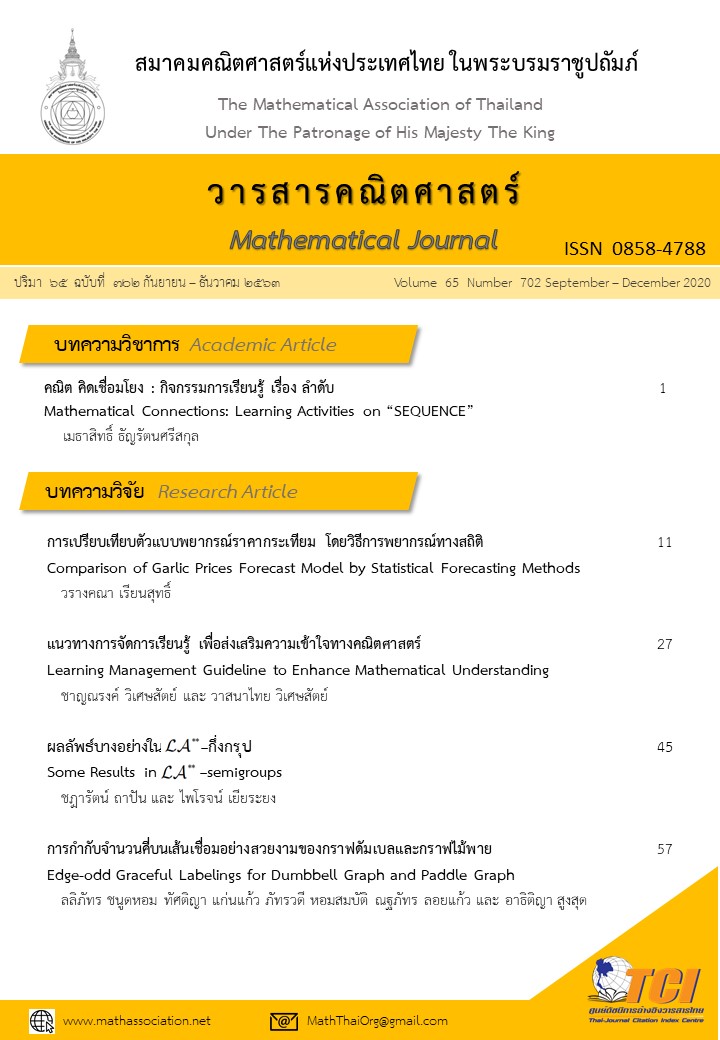Learning Management Guideline to Enhance Mathematical Understanding
Main Article Content
Abstract
This research aimed to study The Learning Management Guideline to Enhance Mathematical Understanding. There were two phases of the study. First, the researcher analyzed the related documents and draft guidelines for learning management. The data sources: researches and 5 Specialist. Research instruments were Analysis of suitable concepts form and suitability assessment form. Second, The fieldwork was applied for authentic study and development learning management guidelines. The data sources: 2 Academy for studying the teaching and learning of mathematics are National Institute of Education (NIE), Singapore and Lamplaimat Pattana School, Thailand. Research instruments were Activities observation form, Activities interview form, Relations analysis form and Suitability assessment form. The results showed that: The syntax of teaching to enhance Mathematical Understanding have 3 steps; Steps 1: concrete, Steps 2: Semi-concrete, Steps 3: Method. The Mathematics Understanding Assessment Guideline have 6 Facets; 1) can explain, 2) can interpret, 3) can apply, 4) have perspective, 5) can empathies and 6) have self – knowledge.
Article Details
References
กระทรวงศึกษาธิการ. (2560). ตัวชี้วัดและสาระการเรียนรู้แกนกลาง กลุ่มสาระการเรียนรู้คณิตศาสตร์ (ฉบับปรับปรุง พ.ศ. 2560) ตามหลักสูตรแกนกลางการศึกษาขั้นพื้นฐาน พุทธศักราช 2551. กรุงเทพฯ: โรงพิมพ์ชุมนุมสหกรณ์การเกษตรแห่งประเทศไทย.
Ministry of Education. (2017). Indicators and core content Group learning mathematics (Revised edition B.E. 2560) according to The Basic Education Core Curriculum B.E. 2551. Bangkok: Printing Agriculture Cooperatives of Thailand.
ชาญณรงค์ วิเศษสัตย์. (2554). คณิตศาสตร์นอกกะลา. มหาสารคาม : สำนักพิมพ์โรงเรียนลำปลายมาศพัฒนา.
Wisetsat, C. (2011). Mathematics outside the box. Mahasarakham. Lamplaimat Pattana School Printing.
บุญชม ศรีสะอาด. (2553). การวิจัยเบื้องต้น. (พิมพ์ครั้งที่ 8). กรุงเทพฯ: สุวีริยสาสน์.
Srisa-ard, B. (2010). Preliminary research (8th ed.). Bangkok: Suwiriyasan Printing.
ราชิต สุพร (2554). การสอนคณิตศาสตร์ระดับประถมศึกษาผ่านสื่อชุดแผ่นร้อย. มายแมท (MY MATHS). 9(75): น. 55 - 58.
Suporn, R. (2011). Teaching elementary school mathematics through the sheet set, ten hundred square units. MY MATHS. 9(75): p. 55 - 58.
วิเชียร ไชยบัง. (2561). โรงเรียนนอกกะลา (ภาคปาฏิหาริย์). พิมพ์ครั้งที่ 18. บุรีรัมย์: สำนักพิมพ์เรียนนอกกะลา.
Chalakbang, W. (2018). The School outside the box (Miracle version) (18th ed.). Buriram: Learn Nokkala Printing.
Barmby, P. (2009). Primary mathematics: teaching for understanding. McGraw-Hill Education.
Charlesworth, R. (2011). Experiences in math for young children (6th ed.). Belmont, CA: Wadsworth/Cengage Learning.
Edwards, A. (2012). New technology and education. London: A&C Black.
Hiebert, J., and Carpenter, T. P. (1992). Learning and teaching with understanding.
In D. A. Grouws (Ed.), Handbook of research on mathematics teaching and learning. New York: Mcmillan.
Inprasitha, M. (2003). Reforming of the learning processes in school mathematics with emphasizing on mathematical process. Bangkok: National Research Council of Thailand.
Inprasitha, M., Masamo, I., and Ban-Har, Y. (Eds.). (2015). Lesson study: Challenges in mathematics education. Singapore: World Scientific.
The National council of Teachers of Mathematics. (2000). Principles and Standards for School Mathematics. Reston, VA: NCTM.
Wiggins, G. P., and McTighe, J. (2005). Understanding by design. Ascd.


